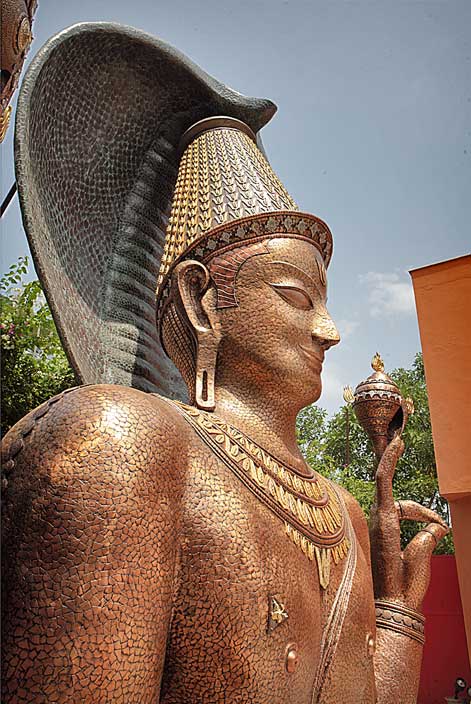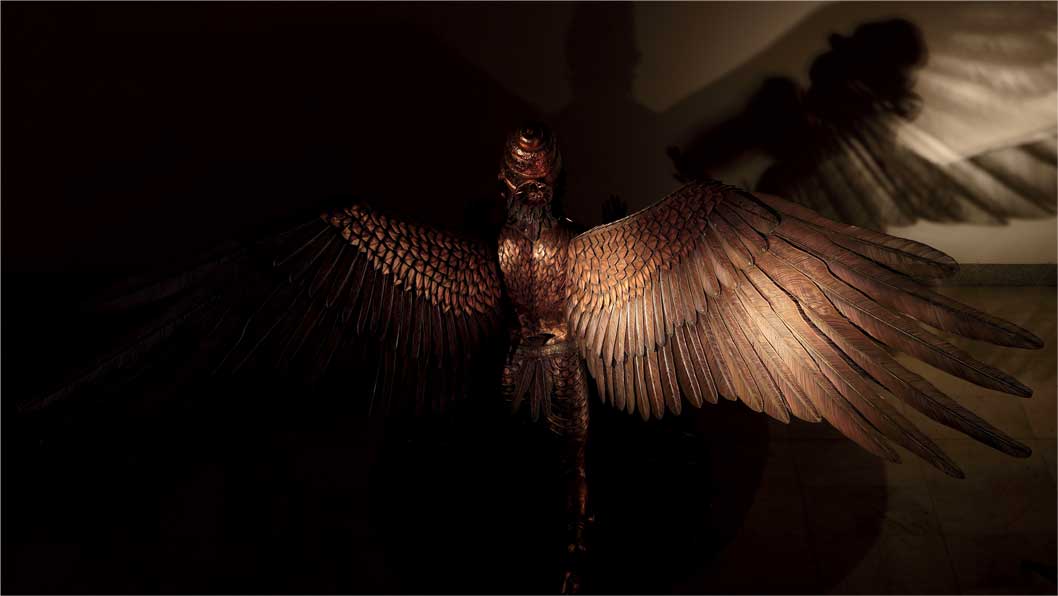(August 26, 2024) About 25 years ago, Satish Gupta fell from the roof and broke his wrist. The doctor misaligned the bones, put the plaster incorrectly, and eventually had to insert a rod to get it functioning. This whole ordeal took over six months, during which the versatile artist couldn’t paint at all, which was frustrating.
Around that time, while travelling to a studio in Gurgaon from New Delhi one day, he came across iron smiths who were repairing and welding household articles. It fascinated him. Days later, he gathered objects, including large nails and a few oil lamps (diyas), and fashioned a six-inch flower, which was welded together. Thus, his first sculpture was born.
“I never studied sculpture in school or college. I am an accidental sculptor,” smiles word renowned sculptor Satish Gupta, in conversation with Global Indian. With expertise in painting, sculpture, poetry, writing, murals, calligraphy, design and ceramics, Gupta’s art exudes a meditative quality, providing viewers with a serene detachment, showcasing the artist as both the participant and the observer of his life.

Sculptor Satish Gupta
Ambani connection
While he has designed and created stunning pieces of art, Gupta’s gigantic “Vishnu sculpture” and a magnificent “golden tree of life” for the Ambani family, now housed in their iconic home, Antilia, gained significant attention on social media during the recent wedding of Anant Ambani and Radhika.
Nita Ambani happened to visit one of his art shows and asked him what he would create for her. “I suggested an 18-foot Vishnu, but it ended up being 22 feet high by 22 feet wide,” smiles Gupta, whose works were also acquired by The Museum Of Sacred Arts, Brussels.
The inspiration, he says, came during a sail down the Nile, where he saw the giant heads of pharaohs gazing at the stars, linking him to the omnipresent and timeless Vishnu. “I wanted to capture Vishnu’s immense power, bursting with energy like a supernova, while maintaining his calm and serene expression. The sculpture took two years to create, with a team of 20 assistants working 24/7.”
Studying a feather from the Crown Eagle inspired Gupta to create Vishnu’s Garuda. “I incorporated his five attributes: Strength, Devotion, Wisdom, Progress, and Knowledge. The sculpture represents his immense strength and humility, with his hands folded in reverence and wisdom to remain with Narayan in complete surrender.”

Vishnu, The Radiant One. Photo: Satish Gupta
He says it would have been impossible to achieve such a work without the active cooperation of The Lord himself. “This is a Swayambhu, I did not create it.”
For Nita Ambani’s 50th birthday celebrations, she asked Gupta to create a Tree of Life. “I crafted a golden tree with the fruits of life and silver birds perched on its branches. It was the most opulent sculpture I have done, fitting for the occasion,” says Gupta. It was displayed in the central cupola of Umaid Bhawan and now proudly stands in Antilia.
Zen sculptures
In his initial days as a sculptor, Gupta created a series of Zen sculptures and held a show. After seeing this show, the owners of a business house asked if he would create a group of five sculptures for their corporate office.
“I accepted the challenge without hesitation. The project had to be completed in two years—enough time for me to learn the art of sculpture and create it, I thought. The installation of the five sculptures I proposed represented the five primal elements and ranged in height from 11 to 32 feet.”
For a year, he traveled the world studying monumental sculptures to learn from them. While his studio in Gurgaon was under construction, Gupta stacked plywood boxes in his gallery space to get a sense of volume, as the sculptures were enormous.
Torso & shock
He created the first sculpture maquette traditionally in clay — a 20-foot torso of a man flying. His clients saw the work and loved it. The next day, the maquette was to go for casting in bronze. “However, when I arrived at my studio, I was shocked to find that the caretaker and laborers, instead of removing the plywood boxes, had destroyed the sculpture and were dancing with the broken parts!”
After recovering from the shock, Gupta called the clients, informed them that he could create something better, and proposed to meditate and create the sculptures on-site. “I had no clear plan but was certain that with the time constraint, I couldn’t create five monumental sculptures in the traditional, time-consuming way,” he recalls.

‘The Worshipping Garuda’ by Satish Gupta.
After a week of meditation and living on-site, Gupta still had no solution until one night, inspired by a terracotta pot and some torn newspaper, he had a breakthrough. “It started drizzling, and I stuck a moist piece of newspaper on the pot. This was my Eureka moment! My technique of welding square copper pieces, which I call the “accidental sculptor” method, was born out of necessity,” smiles the multi-faceted artist.
Without formal training in sculpture, he was free to think outside the box and break all the rules.
Spiritual experience
When working on his first major sculpture, ‘Kalyansundara’—the 11-foot high head of Shiva— Gupta had an intense spiritual experience.
His technique involves first molding the armature in copper, then welding ‘the skin,’ composed of thousands of one-inch square copper pieces, like a mosaic on the structure, starting from the top of the head. This process can sometimes take months. “When I had just welded the pieces on the eyes, the sculpture seemed to smile, and from that point on, it took over and rapidly created itself. In just three short weeks, working around the clock, the sculpture was complete. It is a SWAYAMBHU, the self-created, I merely facilitated its birth.”
He says the intense energy passing through his body was overwhelming. “I almost lost my sight. A friend told me that Shiva’s energy absorbs your own, like a black hole, and to balance it, you need to create a Vishnu, akin to a supernova,” says the septuagenarian.
Eclectic themes
Sanjay Gupta’s themes are eclectic. “I don’t restrict my creativity and always express myself in the medium, form, and scale that the artwork demands at that moment. I strive not to be a prisoner of my persona, which can confine creativity,” says the world renowned sculptor, who also collaborated with Prime Minister Narendra Modi on the charity auctioned sculpture painting “Om Namo Shivaya” at Sotheby’s.
Even though a developed style can become a signature, it is challenging to break out of it and surprise oneself. The common thread linking his realistic and abstract works is a sense of serenity, whether it’s from his art work ‘Kasim’ from the Eyes of the Thar series or ‘The Cosmic Wave.’
Once Sadhguru visited his studio, saw Gupta’s sculpture of Ganesha, and blessed it. “He then asked me to create the utsav murti of Linga Bhairavi. Despite the short timeframe of three months, I was honored that the sculpture resides in the Isha temple in Coimbatore and is revered by millions,” says the renowned sculptor, whose works were exhibited in the show “Forms of Devotion” in Thailand and the Shanghai Museum of Modern Art.

Photo: Isha Foundation
Noble metal
Gupta primarily uses copper for his sculptures. He describes it as a noble metal, hard yet soft, and develops a beautiful patina as it ages. “I love working on a grand scale, but scale alone is not enough. Even my first six-inch sculpture has a monumental quality, while some large sculptures can appear toy-like,” explains Gupta, who rarely creates smaller models before enlarging them. Instead, he works directly on the final scale, allowing the creation to flow naturally and guide itself.
By staying open to the possibilities that the work offers, magical transformations can occur, says Gupta, whose works are often gigantic and are displayed in museums, airports and hotels.
Born in 1947, Satish Gupta studied at the College of Art, New Delhi. In 1970, he studied graphics in Paris on a scholarship for two years. While there, he encountered a Zen book that became pivotal in shaping his spiritual reflection, evident in his works.
His works
“MA” was one such painting, which was 1.6 kilometres long on the beach in Puducherry, perhaps the longest in the world. He also has a 23 feet sculpture in Copper “The Buddhas Within” in the permanent collections of the Prince Of Wales Museum and CSMVS in Mumbai. His sculpture on The Sun God is at the International Airport in New Delhi and created a 30 feet long mural for the Bengaluru International Airport.
Another monumental 5 piece metal sculpture ranging from 11.5 feet to 35 feet in height and weighing over 22,000 pounds inspired by the five primal elements, is located at the Jindal Center in New Delhi. Satish Gupta has exhibited at more than 37 solo shows at important art galleries within the country and abroad.
His zen works were exhibited in the Ethnographic Museum in Slovenia. Besides, they have also been exhibited at the Venice Biennale and Art Laguna, Arsenal and at The Deborah Colton Gallery in Houston in 2017. Gupta sculpted the Utsav Murti of ‘Ling Bhairavi’ for Sadhguru’s Isha Ashram in Coimbatore.His most expensive piece to date is the ‘Eternal Flight’ group of sculptures, costing 15 crores.

Inspiration
Ask him what was a major influence in his sculptural pursuit, Gupta says he is open to life and draws inspiration from everything — from observing a lotus opening its petals to the waves rushing over timeless rocks.
“Inspirations include Kailashnath Temple, Chola bronzes, the frescoes of Pompeii, and a painted stone idol of Ganesha by the roadside in Rajasthan. The list is endless,” says Gupta, who authored a book ‘Zen Whispers’ which was released at the Jaipur Literature Festival in 2018.
Future plans ? “I do not plan the future. Instead, I focus on being aware of each moment and living it intensely.”



